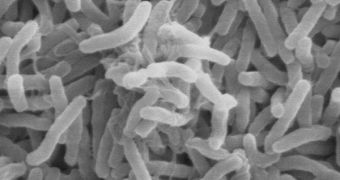More than 2.75 billion years ago, our planet wasn't anything like the cradle of life it is today. The very tiny amount of organisms that were able to withstand living without oxygen, and under direct bombardment from ultraviolet (UV) radiation were hiding on the ocean floor, deep down underground, or were producing thin layers of proteins. These “shields” protected them from radiation, and allowed them to go on. Rather than employing such crude defenses, a type of bacteria simply learned to dig, and made for itself caves to live in. The find could have significant implications for finding life on other planets, experts believe.
That is to say, the tiny organisms would have found it to be a lot less energy-consuming if they had simply shielded themselves from the sunlight completely. The small caves that were discovered in Australia, no more than a centimeter in depth, and a few millimeters wide, are the results of thousands of generations of bacteria digging for shelter on the floors of lakes and seas. What's truly weird about these organisms is that they lived long before the first forms of subterranean life appeared, some 1.5 billion years ago. Thus, the bottom-dwelling variety learned to excavate about a billion years before their land-based counterparts did.
The way they “grew” their caves was fairly ingenious. They would grow, generation after generation, and form air-tight sheets of organisms, living just under the lake floors. Over time, as methane gas rose from within the ground, they trapped and stored it, which made the entire crust above them rise. As that happened, water seeped in, and the organisms descended even lower. For living things smaller in size than the tip of a needle, descending more than a centimeter underground is a huge accomplishment, which has only been recently demonstrated by expert Birger Rasmussen, based at the Curtin University of Technology, in Bentley, Australia, Discovery News reports.
The research team is yet unsure what bacteria used as a source of sustenance. While some believe that they would have fed on methane directly, others hypothesize that, when their caves expanded, the water coming in would have brought with it sulfur, or other chemicals. Either way, it's remarkable that something so small could have constructed a structure equivalent to a space elevator, for us humans. “Cavity dwelling would've been a good way of escaping harsh radiation at the surface. The cavities were protected and probably had water seeping through,” Rasmussen concluded.
The find could have important consequences on the methods that researchers use to detect life on other planets, and notably Mars. That is to say, if these organisms managed to survive here, then why couldn't they have done so on the Red Planet as well? Undoubtedly, the researchers think, future missions to Mars will be equipped with instruments able to detect this type of construction in the soil.

 14 DAY TRIAL //
14 DAY TRIAL //